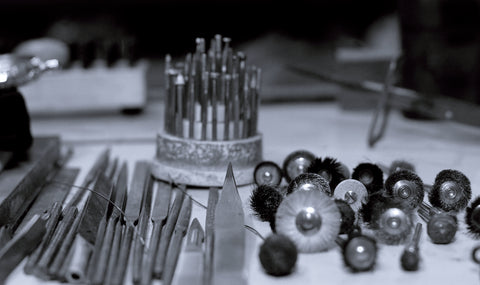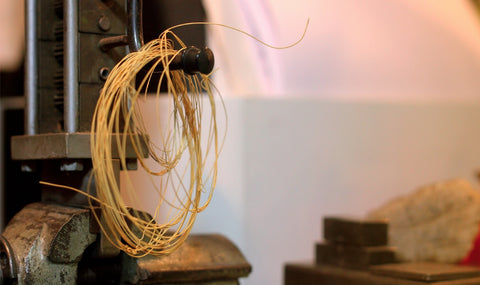Each Marina Ferraro jewel is made with the best materials on the market, Gold, 925 Silver,Red Coral, Pink Coral and semi precious stones. All always supplied with certification of authenticity.

Our creations are handcrafted because we believe in values and the beauty of artisanal production . The details, the imperfections, make each jewel unique and different.
Our main works are Rubrum Coral (red) and Filigree in gold or silver, here is a brief description of both.
- Red coral of Alghero, Corallium rubrum:Whether it is a smooth coral or engraving process, the production chain certainly starts with the choice of the piece raw coral.
To do this, you need to wash the Coral for eliminate all the part that covers the branch , for a more detailed view of color, quality and size.

Then there is a first selection and you start cutting according to the type of processing. As for the smooth coral, the pieces are riddled with a special tool in order to divide them by size and then for color and quality . According to the finished product to be produced, these pieces will first be flattened and then rounded giving it the desired shape.
Depending on the production you want the pieces will come laundry , through hole or half hole.In the past this phase was carried out with a bow-shaped instrument with a steel tip. Today, however, this tool gives way to semi-automatic machines that allow us to save time and with superior quality.
As regards, however, the engravings , the craftsman rounds ("aggarba") the rough piece of Coral giving a rounded shape. He then moves on to putting the piece of Coral in pitch on wooden sticks (fused) with hot mastic, which will allow the craftsman to easily manipulate the piece.
He therefore begins to engrave the Coral thanks to the use of precision tools, such as jokers or electric motors, giving space for your own imagination , guided and inspired by the Coral branch itself. One of the last phases of the supply chain is the same for both types of processing, that is the purification and cleaning phase of the Coral which will give it its shine.

For the majority of the production of the smooth, we pass, finally, to threading of these now finished elements of Coral, forming Necklaces of various lengths.
The processing of thewatermark
The processing of filigree is an ancient technique performed entirely by hand without the aid of special machinery and following a process that exactly follows traditional techniques.
But before processing the wire, we will illustrate the various processing stages that lead the metal to become a Sardinian jewel of great value.
The phases can be divided into five:
Melting of the metal
Lamination
Drawing
Processing
Polishing
Sardinian filigree: Fusion
The first stage of processing consists in subjecting the metal, placed in a crucible in refractory earth, to a high heat treatment (until the melting threshold is reached). However, since gold is a soft metal, it cannot be used alone for the production of jewelry. It is for this reason that the noble metal is always bound to other metals which give it greater hardness. These skilful combinations that make the metal take on different colors are called alloys, and it is from this union that we obtain the various types of gold:yellow gold, white, pink, etc.
Once the metal has been melted in the crucible with a blown or foot blown torch, it is poured into an ingot mold and allowed to cool.
We thus move on to the second stage of processing.
Sardinian filigree: Lamination
The cooled metal bar is extracted from the mold and passed through a rolling mill in order to reduce its thickness more and more. The rolling mill is composed of two superimposed steel or cast iron cylinders which rotate in the opposite direction. The bar is then passed through grooves which progressively decrease, thus reducing the thickness of the wire up to one millimeter. During this process it is essential to re-cook the wire, in order to make it resistant to elongation again.
Once this thin thread has been obtained, we proceed to the third stage of processing.
Sardinian filigree: Drawing
This phase consists in obtaining an even finer reduction of the wire, introducing it into small dies of stone or steel of ever smaller dimensions until the desired thickness is obtained. Even during drawing it is essential to re-bake the metal in order to reinvigorate it and make it elastic again. Depending on the object to be made, the thickness of the wire can reach very fine sections, even 0.15 mm.
The phases that we have analyzed above are typical of any goldsmith process, while the last is the fundamental phase that distinguishes the watermark from the other processes.
Sardinian filigree: Twisting
This process consists in intertwining several distinct threads by sliding them on two wooden boards so as to assemble into a long braid.
The twisting must be homogeneous in the sense that it must have an equal number of turns per unit of
equal length. As for the lamination, also in the case of twisting the intertwined wires must be subjected to annealing
Filigree processing
There are two ways of working the watermark:
• “open: it consists in making the structure of the jewel and then filling it with wire already wound in a spiral and then welding it with the underlying structure in contact pointso
• “at night: a support is used on which the twisted and shaped wire is welded in different waysi
forms.
Polishing
The last phase is polishing, which ensures that the watermark just worked is eliminated of the residual opacity of the metal, acquiring a bright and luminous color.of the metal.






